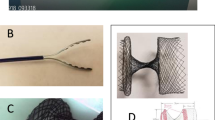Abstract
Objective
Distraction enterogenesis may provide a novel therapy for short bowel syndrome (SBS). Previously described methods have relied upon isolated intestinal segments or transmural fixation. Our objective was to develop a novel, fully endoluminal device, permitting placement and removal through an enteral stoma or orifice.
Methods
A flexible device was designed consisting of two latex balloons mounted on coaxial catheters. The inner catheter allowed longitudinal force transmission from an external spring. Yorkshire pigs underwent jejunal Roux limb creation with device placement via jejunostomy. Balloons were inflated to 52 mmHg without significant reduction in bowel perfusion as measured by laser Doppler. The device was explanted after 7 days.
Results
Distracted bowel achieved an increase in length of 26.1 ± 6.1 % vs nondistracted fed bowel. As the device resided in unfed bowel, a 66.7 ± 14.5 % increase vs unfed bowel was noted. These corresponded to a gain of 6.3 ± 2.3 cm (0.9 ± 0.3 cm/day) and 12.9 ± 7.6 cm (1.8 ± 1.1 cm/day), respectively. Attachment sites demonstrated occasional epithelial sloughing with no balloon-associated perforation.
Conclusion
A novel double-balloon catheter device allows for fully endoluminal distraction enterogenesis. This approach may allow development of clinically applicable technology for the treatment of patients with SBS.





Similar content being viewed by others
References
Squires RH, Duggan C, Teitelbaum DH, Wales PW, Balint J, Venick R, Rhee S, Sudan D, Mercer D, Martinez JA, Carter BA, Soden J, Horslen S, Rudolph JA, Kocoshis S, Superina R, Lawlor S, Haller T, Kurs-Lasky M, Belle SH, Pediatric Intestinal Failure C (2012) Natural history of pediatric intestinal failure: initial report from the Pediatric Intestinal Failure Consortium. J Pediatr 161(4):723–728. doi:10.1016/j.jpeds.2012.03.062
Spencer AU, Neaga A, West B, Safran J, Brown P, Btaiche I, Kuzma-O’Reilly B, Teitelbaum DH (2005) Pediatric short bowel syndrome: redefining predictors of success. Ann Surg 242(3):403–409 (discussion 409–412)
Bianchi A (1980) Intestinal loop lengthening–a technique for increasing small intestinal length. J Pediatr Surg 15(2):145–151
Kimura K, Soper RT (1990) Isolated bowel segment (model 1): creation by myoenteropexy. J Pediatr Surg 25(5):512–513
Kim HB, Lee PW, Garza J, Duggan C, Fauza D, Jaksic T (2003) Serial transverse enteroplasty for short bowel syndrome: a case report. J Pediatr Surg 38(6):881–885
Sudan D, Thompson J, Botha J, Grant W, Antonson D, Raynor S, Langnas A (2007) Comparison of intestinal lengthening procedures for patients with short bowel syndrome. Ann Surg 246(4):593–601. doi:10.1097/SLA.0b013e318155aa0c (discussion 601–594)
Lao OB, Healey PJ, Perkins JD, Horslen S, Reyes JD, Goldin AB (2010) Outcomes in children after intestinal transplant. Pediatrics 125(3):e550–e558. doi:10.1542/peds.2009-1713
Park J, Puapong DP, Wu BM, Atkinson JB, Dunn JC (2004) Enterogenesis by mechanical lengthening: morphology and function of the lengthened small intestine. J Pediatr Surg 39(12):1823–1827
Safford SD, Freemerman AJ, Safford KM, Bentley R, Skinner MA (2005) Longitudinal mechanical tension induces growth in the small bowel of juvenile rats. Gut 54(8):1085–1090. doi:10.1136/gut.2004.061481
Spencer AU, Sun X, El-Sawaf M, Haxhija EQ, Brei D, Luntz J, Yang H, Teitelbaum DH (2006) Enterogenesis in a clinically feasible model of mechanical small-bowel lengthening. Surgery 140(2):212–220. doi:10.1016/j.surg.2006.03.005
Miyasaka EA, Okawada M, Utter B, Mustafa-Maria H, Luntz J, Brei D, Teitelbaum DH (2010) Application of distractive forces to the small intestine: defining safe limits. J Surg Res 163(2):169–175. doi:10.1016/j.jss.2010.03.060
Koga H, Sun X, Yang H, Nose K, Somara S, Bitar KN, Owyang C, Okawada M, Teitelbaum DH (2012) Distraction-induced intestinal enterogenesis: preservation of intestinal function and lengthening after reimplantation into normal jejunum. Ann Surg 255(2):302–310. doi:10.1097/SLA.0b013e318233097c
Sullins VF, Wagner JP, Walthers CM, Chiang EK, Lee SL, Wu BM, Dunn JC (2014) Function of mechanically lengthened jejunum after restoration into continuity. J Pediatr Surg 49(6):971–974. doi:10.1016/j.jpedsurg.2014.01.033 (discussion 974–975)
Okawada M, Maria HM, Teitelbaum DH (2011) Distraction induced enterogenesis: a unique mouse model using polyethylene glycol. J Surg Res 170(1):41–47. doi:10.1016/j.jss.2011.03.041
Ralls MW, Sueyoshi R, Herman RS, Utter B, Czarnocki I, Si N, Luntz J, Brei D, Teitelbaum DH (2013) Mesenteric neovascularization with distraction-induced intestinal growth: enterogenesis. Pediatr Surg Int 29(1):33–39. doi:10.1007/s00383-012-3204-5
Ralls MW, Sueyoshi R, Herman R, Utter B, Czarnocki I, Luntz J, Brei D, Teitelbaum DH (2013) Development of a novel approach to safely couple the intestine to a distraction-induced device for intestinal growth: use of reconstructive tissue matrix. Pediatr Surg Int 29(2):151–156. doi:10.1007/s00383-012-3198-z
Chawla BK, Teitelbaum DH (2013) Profound systemic inflammatory response syndrome following non-emergent intestinal surgery in children. J Pediatr Surg 48(9):1936–1940. doi:10.1016/j.jpedsurg.2013.05.065
Stark R, Zupekan T, Bondada S, Dunn JC (2011) Restoration of mechanically lengthened jejunum into intestinal continuity in rats. J Pediatr Surg 46(12):2321–2326. doi:10.1016/j.jpedsurg.2011.09.019
Riordan CL, McDonough M, Davidson JM, Corley R, Perlov C, Barton R, Guy J, Nanney LB (2003) Noncontact laser Doppler imaging in burn depth analysis of the extremities. J Burn Care Rehabil 24(4):177–186. doi:10.1097/01.BCR.0000075966.50533.B0
Goldstein RM, Hebiguchi T, Luk GD, Taqi F, Guilarte TR, Franklin FA Jr, Niemiec PW, Dudgeon DL (1985) The effects of total parenteral nutrition on gastrointestinal growth and development. J Pediatr Surg 20(6):785–791
May A, Nachbar L, Wardak A, Yamamoto H, Ell C (2003) Double-balloon enteroscopy: preliminary experience in patients with obscure gastrointestinal bleeding or chronic abdominal pain. Endoscopy 35(12):985–991. doi:10.1055/s-2003-44582
Wales PW, Jancelewicz T, Romao RL, Piper HG, de Silva NT, Avitzur Y (2013) Delayed primary serial transverse enteroplasty as a novel management strategy for infants with congenital ultra-short bowel syndrome. J Pediatr Surg 48(5):993–999. doi:10.1016/j.jpedsurg.2013.02.015
Acknowledgments
Gail Rising, DVM, Amber Yanovich, LVT, and Janet Wolforth, LVT provided veterinary care and their contributions are appreciated. This research was supported by NIH 2R44DK085765-02, FDA P50 Pediatric Device Consortia Grant 2-P50-FD-003787-03, and a Hartwell Biomedical Research Award.
Conflict of interest
The authors declare no conflicts of interest relevant to this work.
Author information
Authors and Affiliations
Corresponding author
Rights and permissions
About this article
Cite this article
Demehri, F.R., Wong, P.M., Freeman, J.J. et al. A novel double-balloon catheter device for fully endoluminal intestinal lengthening. Pediatr Surg Int 30, 1223–1229 (2014). https://doi.org/10.1007/s00383-014-3612-9
Accepted:
Published:
Issue Date:
DOI: https://doi.org/10.1007/s00383-014-3612-9




